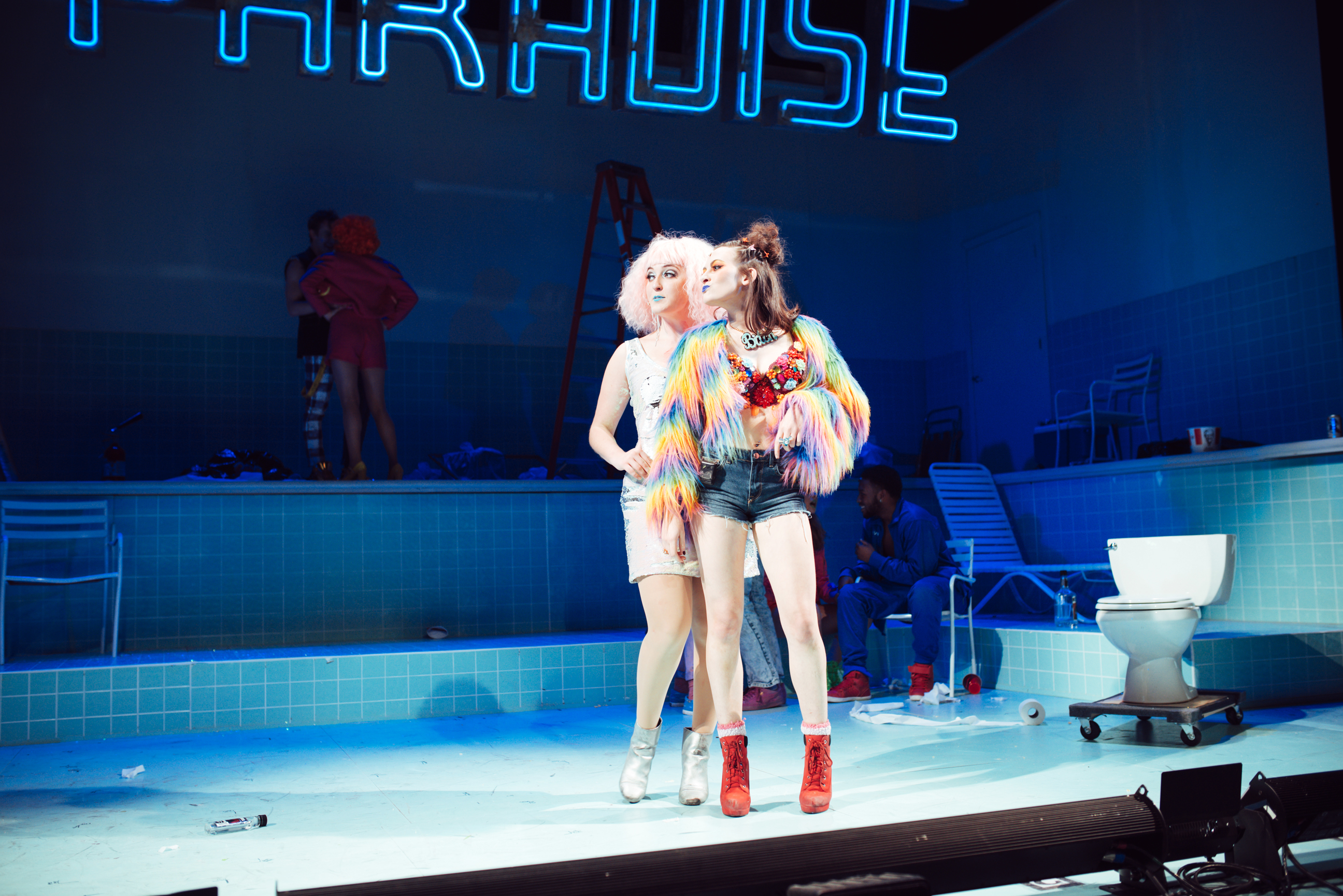
Courtesy Andrew Schmidt
Center stage, a pink-wigged mannequin head greets audience members, waiting with them for the lights to go down.
When they finally do, a raunchy, dissonant jazz note bleats, kicking off a musical overture with a tone reminiscent of the exaggerated sexuality and captivating sleaziness of Chicago. Cue the burlesque dancers, clad in different variations of sparkly black bralettes and hot pants. The protagonist, Queenie (Ginna Doyle ’17), struts through the audience, right down the center aisle, wearing lingerie, a silk robe and a wig cap. She clambers onto the stage and pauses dramatically before putting on the pink wig. Then the party starts and quite honestly never stops.
The curtain rises to reveal a bizarre conglomeration of set pieces: pool deck chairs, ladders and even a toilet. The stage is a blue-tiled public pool. An enormous neon sign hangs in midair, reading “paradise,” a word that will prove to be ironic as the play proceeds.
Queenie, unsatisfied with her monotonous sexual experiences and partners, begins a tempestuous relationship with Burrs (Christian Probst ’17), a vaudevillian clown (eerily coincidental given this year’s “scary clown” epidemic). The play’s fast-paced introduction keeps viewers on their toes.
Despite their sexual passion, the two lovers cannot escape the fickleness of their lives — the pursuit of instant gratification and the subsequent ennui. Moreover, Burrs’ boredom tips him over the edge, causing him to express his unrest through physical and verbal abuse of Queenie.
Here’s where the party part comes in: After a scandalous depiction of masturbation and a bone-chilling episode of domestic violence — intensified by the fabulous soloist riffs of an ensemble member — Queenie decides she must reawaken the excitement of their relationship by throwing a party. Based on disturbing prior events, the audience knows this is going to end in terrible disaster.
Director Zi Alikhan’s futuristic rendition of Andrew Lippa’s roaring 1920s dinner party looks uncannily like a cross between a trippy Miley Cyrus music video and a night at Toad’s gone horrendously wrong. One outlandish scene after the next sweeps the audience into a frenzied whirlwind featuring clouds of illegal drugs, bubble gum pop clothing a la Lisa Frank and copious amounts of arousal.
The party elevates the play from a trite love triangle — or love square in this case — to a provocative exploration of themes such as assault, queerness and substance abuse.
The exhausting and quite unsettling portrayals of hedonistic consumption are punctuated by whimsical reprieves. One partygoer belts out her desire for “a good, old-fashioned, lesbian love story.” Another couple croons to one another that they are “two of a kind,” and we’re sure glad somebody found love amid all the unsentimental lasciviousness.
Finally — the wrench(es) in Queenie’s plot.
Enter Kate (Michaela Murphy ’17). She’s wearing an outfit to rival the entire Coachella festival itself: a rainbow fur capelet, Daisy Dukes and an avant-garde bra top replete with bedazzled gems, flowers and fringes. She’s sexy, self-indulgent and a bit bonkers. She wants Burrs. I want her outfit.
Enter Mr. Black (Kenyon Duncan ’18) — the hot topic of this year’s Dramat controversy. Black’s character is scandalous in his own right, instantly intriguing Queenie with his cool, self-possessed demeanor, causing her to lose sight of why she threw this rager in the first place.
Duncan’s portrayal of debonair Black was spot-on, although, more importantly, after listening to Duncan’s seductively smooth voice for two hours, I am impatiently awaiting the release of his first R&B album.
Act 1 concludes with Queenie’s existential love crisis, torn between status quo and new sexual escapade — which ironically is her status quo anyway. Should she stay with Burrs or pursue Black?
At intermission, the audience is totally drained. It has not even been two hours, but somehow it feels like this party has been going on for days.
Compared to the first act, the second falls a bit flat. The music loses its risque originality, its saucy flavor, as the company sings mostly reprises. Predictably, tragedy ensues, culminating in a literal bang.
While the climax may be a bit cliche, Doyle, Probst and Duncan paint a believably heartfelt portrait of lust, angst and grief. The saving grace of Act 2 is the end of the show, as Queenie strips naked, and the lights go down for the final time. The scene is so frustratingly perplexing that the audience members stare at the curtain long after the play ends, contemplating their own existential crises and wishing for change or rebirth.
The play is not a joyride by any means, but it is riveting, shocking and completely addictive. Ultimately, what makes “The Wild Party” so successful is how disturbingly realistic it is, how it drags audience members to a party they didn’t even want to attend.







